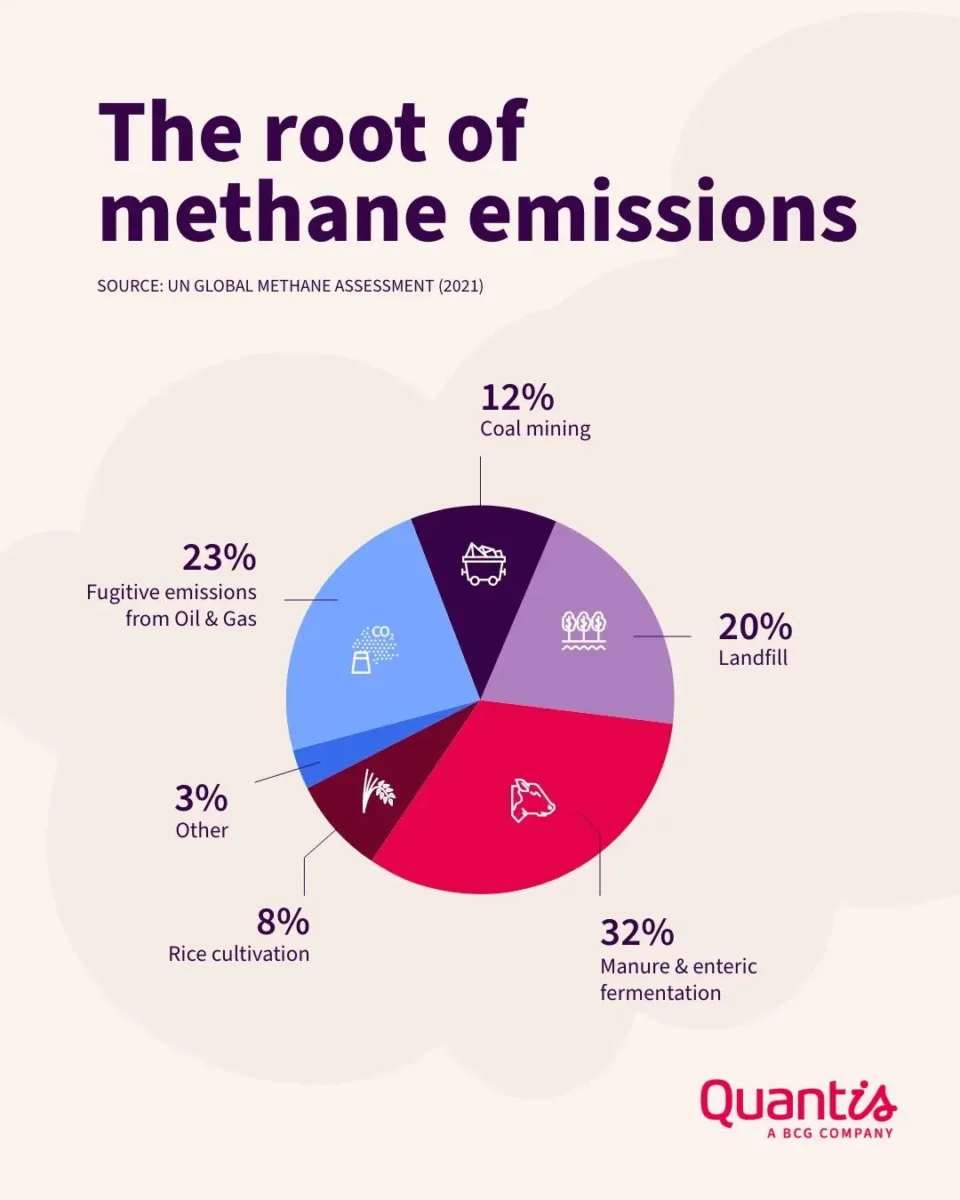In brief:
- Methane is a substantial contributor to global temperature rise and originates from a variety of sources, ranging from natural gas to rice paddies.
- Since greenhouse gas (GHG) emissions are often reported as carbon dioxide equivalent, the magnitude of methane’s impact has been largely overlooked.
- Methane is a potent, but short-lived greenhouse gas; addressing methane emissions now can help turn the tide on global temperature rise to reach Paris Agreement goals.
- With 60% of methane coming from human activities such as agriculture and energy leaks, there are proven solutions available to mitigate emissions.
While carbon dioxide (CO2) dominates headlines about the climate emergency, another even more pernicious gas, methane (CH4), shares the blame for pushing our planet towards a tipping point.
In terms of Global Warming Potential (GWP) methane packs a huge punch. And the worrying thing is, we’re pumping out the gas at a faster rate than any time since the 1980s.
But there is a silver lining. As a short-lived climate pollutant, methane’s effects are realized over its 10-12 year lifespan in the atmosphere (compared to hundreds of years for carbon dioxide). Methane is constantly being destroyed through natural processes, such as chemical oxidation reactions, so by reducing human-generated methane now, the atmosphere would benefit relatively quickly. By tackling the sources of methane to bring down emissions companies can also drive reductions in carbon and in many cases, realize better results in the near-term to help us stick to the 1.5C target enshrined in the Paris Agreement.
Seeing methane for what it is
Methane reduction tactics have been under-exploited, leaving untapped reduction potential. This is, in part, due to our global carbon fixation, which risks creating a methane blind spot, such that many business leaders may not fully grasp the threat posed by this potent greenhouse gas (GHG) to the degree they should.
All this is not to say that addressing our mounting methane problem isn’t getting at least some attention. It’s worth mentioning ongoing efforts such as the Global Methane Pledge, initiated by the United States and European Union in late 2021. There is a clear and growing focus on addressing CH4 – but there’s much more to do and urgently.
GHGs are measured in terms of GWP with the GWP100 being the most commonly accepted method of calculation, which measures over a 100-year span. According to the US Environmental Protection Agency, methane is approximately 30 times more potent than CO2 over a 100-year period. But using the 100-year timeframe to assess methane’s GWP doesn’t adequately reflect its short lifespan. Instead, when looked at over a 20-year period, it reveals a warming power 80 times greater than CO2.
This oversight was partly due to early efforts to make global temperature rise and the role of GHGs more easily understood. But the science, and our collective understanding ofthe effects of different gases on the climate, has since evolved.
Is GWP* the solution to a more accurate methane measurement? Since the GWP100 methodology was formulated to calculate the emission and subsequent build-up of GHGs, it doesn’t take their removal into account. This poses challenges in the case of methane because it’s neither calculated on the timescale of the gas’s lifecycle nor does it consider the net effects of its breakdown and removal.
There’s a growing argument that biogenic methane emissions, those released by living organisms (the red balls), should be treated differently than CO2 emissions from fossil fuels (the orange balls). GWP* is a GHG accounting method that takes into consideration methane’s short lifespan, an approach that is more advantageous to legacy methane emitters such as long-time cattle ranching operations.
In effect, unlike CO2, if methane emissions remain constant, there is no additional warming potential from the perspective of the GWP*. Nonetheless, “no additional warming” should not be confused with “no warming.”
This nuance is a sticking point. There’s mounting concerns that GWP* could enable polluting industries to claim they’re climate neutral without significantly cutting emissions.
Some critics, such as Greenpeace, have flagged potential ‘unethical consequences’ of GWP*. They argue it could be used to justify maintaining atmospheric methane levels, rather than trying to reduce them, while punishing new sources of methane in the Global South over existing emitters in the West, such as the American meat industry.
Understanding the Complexity of Methane Emissions: A Toy Store Analogy
Imagine you own a toy store with a bin full of balls whose shipments come at regular intervals. If you had to calculate how many balls it would take to fill the bin to the point thatit’s overflowing (and when)in order to adjust inventory, it would be simple math. But what if thevariables are more complex?

Now imagine the toy balls come in two shipments, as well as two sizes and colors: a larger red ball, and a smaller orange ball. The red balls sell at a consistent rate and the smaller balls don’t sell at all. In this case, the answer to “how many” and “when”would depend on several factors, such as the relative size of the balls, the number and frequency of the deliveries of each, as well as the frequency and volume of the sales.
Though in the big picture you know that if the deliveries keep coming, the bin will overflow, if you need to determine how many and when to direct the suppliers accordingly, it’s not so straightforward.
Stemming the flow of methane at the source
Around 40% of the world’s methane is produced naturally, whether by wetlands, wild animals or events such as wildfires. Global warming is likely to exacerbate this too, with more methane released into the atmosphere as polar ice caps and Arctic permafrost melt.
The remaining 60% is the result of human activities, including livestock farming, rice paddy production, landfills, and leaks from oil and gas infrastructure.
We need to become more methane-aware, and drive methane reductions across the value chain. And for companies, a good first step is to differentiate the gases within their footprint to identify their methane hotspots. This data is usually embedded in traditional GHG accounting that converts all emissions to carbon dioxide equivalent.
Tracking methane emissions separately will enable companies to develop reduction strategies tailored to their own operations and supply chain.

First, stop the leakage
Within oil and gas production, the amount of methane lost through leaking is staggering. Dubbed “fugitive” emissions, gas leaks from wells and pipelines are widespread and pervasive, with data from the monitoring company Kayrros showing that one leak from an oil and gas facility in Turkmenistan peaked at 333 tonnes per hour last August.
The International Energy Agency has estimated the industry could achieve a 75% cut in the (fugitive?) methane it produces simply by using existing technologies, and at little extra cost.
The Agency is also encouraging the sector to capture the gas and sell it as an energy source. In many industrial sectors, methane is seen as a by-product. In mining, for instance, it is vented to avoid potentially explosive build ups, while more controversially, within the oil industry, the gas is simply burnt or flared.
There is support for change. Over 150 countries have now signed the Global Methane Pledge, which commits them to reduce emissions by 30% by 2030, while the US is bringing in new rules requiring fossil fuel companies to monitor and fix leaks. And while several big names are missing from the new Global Flaring and Methane Reduction Partnership, an initial $225m has been pledged to help developing countries plug their methane leaks.
Reducing agriculture’s methane output
Animal agriculture is the top source of anthropogenic methane emissions, due to the large amount of methane produced by ruminant animals such as cows and sheep. Ruminants produce methane through their digestive process, called “enteric fermentation,” and their manure. This puts companies that source dairy and beef in a unique position to make a profound impact on global emissions by addressing methane in their supply chains.
At COP28 last December, six of the world’s largest dairy companies came together to form the Dairy Methane Action Alliance, committing to report their methane emissions and develop mitigation plans. The Alliance provides member companies with technical support for accounting and disclosure, and access to research and emerging solutions.
Fortunately, solutions to livestock methane exist. There are a variety of proven manure management practices that reduce methane, and many countries have government subsidies available to support implementation. There’s also rapid innovation in the market for livestock feed additives that promise to mitigate enteric methane and medications that control methane-producing microorganisms in the cow’s digestive system.
Rice production is another substantial methane emitter, and according to the IPCC is responsible for around 10% of all anthropocentric emissions. But there are alternatives to traditional paddy farming which can reduce these by up to 70%.
Rather than continuous flooding, which produces methane-emitting bacteria, (leading to emissions from the anaerobic breakdown of organic matter), the System of Rice Intensification (SRI) involves alternative periods of wetting and drying, with the paddies drained two or three times during the growing season. The system also uses less water and has been shown to produce higher yields. Dryland ways of rice cultivation go a step further, with crops relying on rainfall with no artificial irrigation, again leading to huge methane reductions.
Companies can support their supplier partners on this journey by providing resources and education to promote the adoption of methane-mitigating practices. By connecting methane hotspots to practical solutions, food sector companies can help mainstream more sustainable ways of farming.
No more methane waste
Waste management systems also release a substantial amount of methane through the decomposition of organic matter in poorly managed settings. Last April, the methane released by one landfill in Bangladesh topped 822 tonnes an hour.
With the world on track to generate 3.40 tonnes of waste a year by 2050 (WorldBank) —roughly 1.7x today’s rate — methane emissions from waste management should be a considerable cause for concern.
Food waste is a tangible area where all companies can make a difference by diverting organic waste from landfill. By upcycling or composting food waste, we can prevent organic waste being sent to landfill where it decomposes and produces methane. Private and public sector collaboration is needed to implement food waste collection and composting at the scale needed to eliminate methane emissions from waste.
Methane as a biofuel
One way to mitigate methane emissions is to harness the gas as a biofuel. Methane capture technologies have been developed for many industries and applications.
As an example, many dairy companies are implementing anaerobic digesters as an effective methane mitigation technology for dairy farms. Digestors capture the methane from dairy manure lagoons and use it to generate electricity or renewable natural gas. These systems not only reduce the climate impact of dairies, but also create a new revenue stream for farmers.
Biofuels derived from anaerobic digestion still produce some emissions, but significantly less than a farm using electricity generated from coal or diesel generators. In the absence of a panacea, it’s important not to be too dogmatic: methane capture can be part of an effective decarbonization strategy as long as it’s not deployed to perpetuate fossil fuel infrastructure or used at the expense of renewables.
Our actions on methane between now and 2030 could be the most important contribution we make to turn the tide on global warming for the short-term. Cutting methane emissions is the best way in which we can have an immediate impact of the rate of global warming.
According to the UN, human-caused methane could be reduced by as much as 45% over the next decade, which could avert nearly 0.3°C of global warming by 2045.
As the chances for remaining within the 1.5°C limit grow increasingly slim, reducing methane in the near term might be our best shot to avert a climate tipping point.






